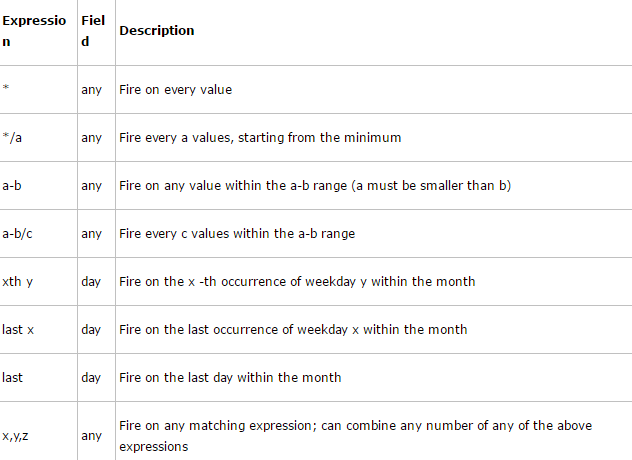Python 定时任务的实现方式
本文转载自:
背景
目前所在的项目组需要经常执行一些定时任务,于是选择使用 Python 的定时器。
Python 实现定时任务
循环 sleep
这种方式最简单,在循环里面放入要执行的任务,然后 sleep 一段时间再执行
1 |
from datetime import datetime |
这个方法的缺点是,只能执行固定间隔时间的任务,如果有定时任务就无法完成,比如早上六点半喊我起床。并且 sleep 是一个阻塞函数,也就是说 sleep 这一段时间,啥都不能做。
threading模块中的Timer
threading 模块中的 Timer 是一个非阻塞函数,比 sleep 稍好一点,不过依然无法喊我起床。
1 |
from datetime import datetime |
Timer 函数第一个参数是时间间隔(单位是秒),第二个参数是要调用的函数名,第三个参数是调用函数的参数(tuple)
使用sched模块
sched 模块是 Python 内置的模块,它是一个调度(延时处理机制),每次想要定时执行某任务都必须写入一个调度。
1 |
import sched |
sched 使用步骤如下:
(1)生成调度器:
s = sched.scheduler(time.time,time.sleep)
第一个参数是一个可以返回时间戳的函数,第二个参数可以在定时未到达之前阻塞。
(2)加入调度事件
其实有 enter、enterabs 等等,我们以 enter 为例子。
s.enter(x1,x2,x3,x4)
四个参数分别为:间隔事件、优先级(用于同时间到达的两个事件同时执行时定序)、被调用触发的函数,给触发函数的参数(注意:一定要以 tuple 给,如果只有一个参数就(xx,))
(3)运行
s.run()
注意 sched 模块不是循环的,一次调度被执行后就 Over 了,如果想再执行,请再次 enter
APScheduler定时框架
终于找到了可以每天定时喊我起床的方式了
APScheduler是一个 Python 定时任务框架,使用起来十分方便。提供了基于日期、固定时间间隔以及 crontab 类型的任务,并且可以持久化任务、并以 daemon 方式运行应用。
使用 APScheduler 需要安装
1 |
$ pip install apscheduler |
首先来看一个周一到周五每天早上6点半喊我起床的例子
1 |
from apscheduler.schedulers.blocking import BlockingScheduler |
代码中的 BlockingScheduler 是什么呢?
BlockingScheduler是APScheduler中的调度器,APScheduler 中有两种常用的调度器,BlockingScheduler 和 BackgroundScheduler,当调度器是应用中唯一要运行的任务时,使用 BlockingSchedule,如果希望调度器在后台执行,使用 BackgroundScheduler。
- BlockingScheduler: use when the scheduler is the only thing running in your process
- BackgroundScheduler: use when you’re not using any of the frameworks below, and want the scheduler to run in the background inside your application
- AsyncIOScheduler: use if your application uses the asyncio module
- GeventScheduler: use if your application uses gevent
- TornadoScheduler: use if you’re building a Tornado application
- TwistedScheduler: use if you’re building a Twisted application
- QtScheduler: use if you’re building a Qt application
APScheduler四个组件
APScheduler 四个组件分别为:触发器(trigger),作业存储(job store),执行器(executor),调度器(scheduler)。
触发器(trigger)
包含调度逻辑,每一个作业有它自己的触发器,用于决定接下来哪一个作业会运行。除了他们自己初始配置意外,触发器完全是无状态的
APScheduler 有三种内建的 trigger:
date: 特定的时间点触发
interval: 固定时间间隔触发
cron: 在特定时间周期性地触发
作业存储(job store)
存储被调度的作业,默认的作业存储是简单地把作业保存在内存中,其他的作业存储是将作业保存在数据库中。一个作业的数据讲在保存在持久化作业存储时被序列化,并在加载时被反序列化。调度器不能分享同一个作业存储。
APScheduler 默认使用 MemoryJobStore,可以修改使用 DB 存储方案
执行器(executor)
处理作业的运行,他们通常通过在作业中提交制定的可调用对象到一个线程或者进城池来进行。当作业完成时,执行器将会通知调度器。
最常用的 executor 有两种:
ProcessPoolExecutor
ThreadPoolExecutor
调度器(scheduler)
通常在应用中只有一个调度器,应用的开发者通常不会直接处理作业存储、调度器和触发器,相反,调度器提供了处理这些的合适的接口。配置作业存储和执行器可以在调度器中完成,例如添加、修改和移除作业。
配置调度器
APScheduler提供了许多不同的方式来配置调度器,你可以使用一个配置字典或者作为参数关键字的方式传入。你也可以先创建调度器,再配置和添加作业,这样你可以在不同的环境中得到更大的灵活性。
下面来看一个简单的 BlockingScheduler 例子
1 |
from apscheduler.schedulers.blocking import BlockingScheduler |
上述代码创建了一个 BlockingScheduler,并使用默认内存存储和默认执行器。(默认选项分别是 MemoryJobStore 和 ThreadPoolExecutor,其中线程池的最大线程数为10)。配置完成后使用 start() 方法来启动。
如果想要显式设置 job store(使用mongo存储)和 executor 可以这样写:
1 |
from datetime import datetime |
在运行程序5秒后,第一次输出时间。
在 MongoDB 中可以看到 job 的状态

对 job 的操作
添加 job
添加job有两种方式:
- add_job()
- scheduled_job()
第二种方法只适用于应用运行期间不会改变的 job,而第一种方法返回一个apscheduler.job.Job 的实例,可以用来改变或者移除 job。
1 |
from apscheduler.schedulers.blocking import BlockingScheduler |
@sched.scheduled_job() 是 Python 的装饰器。
移除 job
移除 job 也有两种方法:
- remove_job()
- job.remove()
remove_job 使用 jobID 移除
job.remove() 使用 add_job() 返回的实例
1 |
job = scheduler.add_job(myfunc, 'interval', minutes=2) |
暂停和恢复 job
暂停一个 job:
1 |
apscheduler.job.Job.pause() |
恢复一个 job:
1 |
apscheduler.job.Job.resume() |
希望你还记得 apscheduler.job.Job 是 add_job() 返回的实例
获取 job 列表
获得可调度 job 列表,可以使用get_jobs() 来完成,它会返回所有的 job 实例。
也可以使用print_jobs() 来输出所有格式化的 job 列表。
修改 job
除了 jobID 之外 job 的所有属性都可以修改,使用 apscheduler.job.Job.modify() 或者 modify_job() 修改一个 job 的属性
1 |
job.modify(max_instances=6, name='Alternate name') |
关闭 job
默认情况下调度器会等待所有的 job 完成后,关闭所有的调度器和作业存储。将 wait 选项设置为 False 可以立即关闭。
1 |
scheduler.shutdown() |
scheduler 事件
scheduler 可以添加事件监听器,并在特殊的时间触发。
1 |
def my_listener(event): |
trigger 规则
date
最基本的一种调度,作业只会执行一次。它的参数如下:
- run_date (datetime|str) – the date/time to run the job at
- timezone (datetime.tzinfo|str) – time zone for run_date if it doesn’t have one already
1 |
from datetime import date |
cron
- year (int|str) – 4-digit year
- month (int|str) – month (1-12)
- day (int|str) – day of the (1-31)
- week (int|str) – ISO week (1-53)
- day_of_week (int|str) – number or name of weekday (0-6 or mon,tue,wed,thu,fri,sat,sun)
- hour (int|str) – hour (0-23)
- minute (int|str) – minute (0-59)
- second (int|str) – second (0-59)
- start_date (datetime|str) – earliest possible date/time to trigger on (inclusive)
- end_date (datetime|str) – latest possible date/time to trigger on (inclusive)
- timezone (datetime.tzinfo|str) – time zone to use for the date/time calculations (defaults to scheduler timezone)
表达式:

1 |
from apscheduler.schedulers.blocking import BlockingScheduler def job_function(): |
interval
参数:
- weeks (int) – number of weeks to wait
- days (int) – number of days to wait
- hours (int) – number of hours to wait
- minutes (int) – number of minutes to wait
- seconds (int) – number of seconds to wait
- start_date (datetime|str) – starting point for the interval calculation
- end_date (datetime|str) – latest possible date/time to trigger on
- timezone (datetime.tzinfo|str) – time zone to use for the date/time calculations
1 |
from datetime import datetime |
Python 定时任务的实现方式的更多相关文章
- Python定时任务
在项目中,我们可能遇到有定时任务的需求.其一:定时执行任务.例如每天早上 8 点定时推送早报.其二:每隔一个时间段就执行任务.比如:每隔一个小时提醒自己起来走动走动,避免长时间坐着.今天,我跟大家分享 ...
- [Dynamic Language] Python定时任务框架
APScheduler是一个Python定时任务框架,使用起来十分方便.提供了基于日期.固定时间间隔以及crontab类型的任务,并且可以持久化任务.并以daemon方式运行应用. 在APSchedu ...
- Python 定时任务框架 APScheduler 详解
APScheduler 最近想写个任务调度程序,于是研究了下 Python 中的任务调度工具,比较有名的是:Celery,RQ,APScheduler. Celery:非常强大的分布式任务调度框架 R ...
- python 定时任务APScheduler 使用介绍
python 定时任务APScheduler 使用介绍 介绍: APScheduler的全称是Advanced Python Scheduler.它是一个轻量级的 Python 定时任务调度框架. ...
- Python文件使用“wb”方式打开,写入内容
Python文件使用"wb"方式打开,写入字符串会报错,因为这种打开方式为:以二进制格式打开一个文件只用于写入.如果该文件已存在则将其覆盖.如果该文件不存在,创建新文件. 所以写入 ...
- python出输出字符串方式:
python出输出字符串方式: >>> who='knights' >>> what='NI' >>> print ('we are the',w ...
- Python定时任务框架APScheduler 3.0.3 Cron示例
APScheduler是基于Quartz的一个Python定时任务框架,实现了Quartz的所有功能,使用起来十分方便.提供了基于日期.固定时间间隔以及crontab类型的任务,并且可以持久化任务.基 ...
- python 定时任务
Python 定时任务 最近学习到了 python 中两种开启定时任务的方法,和大家分享一下心得. sched.scheduler() threading.Timer() sched 定时任务 使用s ...
- Python定时任务框架APScheduler
http://blog.csdn.net/chosen0ne/article/details/7842421 APScheduler是基于Quartz的一个Python定时任务框架,实现了Quartz ...
随机推荐
- 从一个OutOfMemoryError 学会了分析Java内存泄漏问题
以前都是好好的,最近出现了 oom. 问题 开始是: java.lang.OutOfMemoryError: Java heap space -- :: --- [nio--exec-] c.e.p. ...
- Linux下使用docker 拉取 vsftpd 镜像搭建 Ftp 服务器,连接 Ftp 时遇到的错误(425 Failed to establish connection)
Ftp踩坑系列: Linux上的ftp服务器 vsftpd 之配置满天飞--设置匿名用户访问(不弹出用户名密码框)以及其他用户可正常上传 ftp服务器Serv-U 设置允许自动创建不存在的目录 FTP ...
- mysql-5.7.27安装
1,下载5.7.27安装包 百度网盘 (注:5.7.27要安装net faframework4.5.2) 2,创建my.ini及data文件 下载5.7.27后解压,在创建my.ini文件及d ...
- Vue学习笔记Day2
1.mustache语法 如何将data中的文本数据插入到HTML中? 通过使用mustache语法(也就是双大括号),将data中的变量名插入到HTML元素中,显示在页面上. 如下图:并且数据是响应 ...
- dedecmsV5.7 任意文件上传漏洞修复
问题文件:在/include/dialog/select_soft_post.php文件 解决方法: 先找到这个文件/include/dialog/select_soft_post.php,找到大概7 ...
- Linux系统学习 二十一、SAMBA服务—相关文件、配置文件详解
3.相关文件 常用文件: /etc/samba/smb.conf #配置文件 /etc/samba/lmhosts #对应NetBIOS名与主机的IP的文件,一般Samba会自 ...
- leetcode题解:回文数
判断一个整数是否是回文数.回文数是指正序(从左向右)和倒序(从右向左)读都是一样的整数. 示例 1: 输入: 121 输出: true 示例 2: 输入: -121 输出: false 解释: 从左向 ...
- 编辑器之神vim的一些常用快捷键整理
yy:复制 光标所在的这一行 4yy:复制 光标所在行开始向下的4行 p:粘贴 dd:剪切(删除) 光标所在的这一行 4dd:剪切(删除) 光标所在行向下的4行 D:从当前的光标开始向后剪切,一直到行 ...
- Nginx + FastCGI + Django在windows上部署及nginx常用命令
一般应用都是部署在linux系统上,不会在windows上部署,emmm..所以有兴趣的就瞧瞧吧哈哈 nginx工作原理: nginx用于处理静态文件,动态部分经由fastcgi .scgi或uWSG ...
- [算法模板]FFT-快速傅里叶变换
[算法模板]FFT-快速傅里叶变换 感谢ZYW聚聚为我们讲解FFT~ 思路 我懒,思路和证明部分直接贴链接: rvalue LSJ-FFT与NTT基础 代码 主要思想是利用了单位根特殊的性质(n次单位 ...
